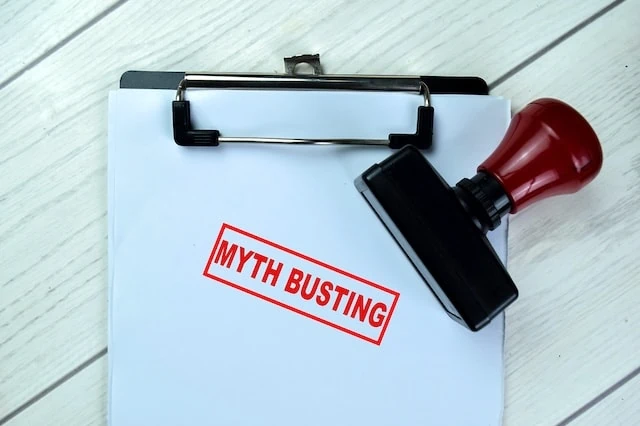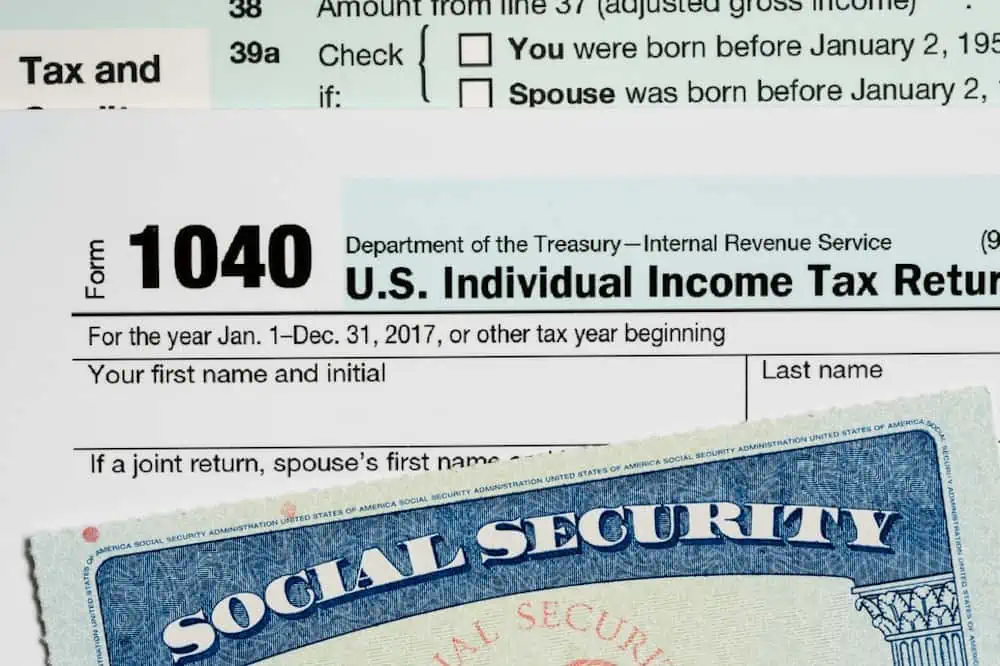You don’t work hard for decades out of boredom. You do it so you have enough money to enjoy retirement—whether you plan on traveling the world, hitting the beach, or just frequently enjoying the company of family and friends in your home.
It’s possible you’ve spent years contributing to savings and retirement accounts to help foot some of those costs. But it’s virtually certain you’ve been paying into Social Security—the backbone of most retirees’ income streams.
Like most federal government programs, Social Security is complex—which in turn leads to a lot of confusion about even some of the program’s most basic rules. That has sprouted dozens of myths that, when taken as truth, can lead to significant retirement planning missteps and financial shortfalls.
Today, then, I’m going to go over some of the most widely repeated myths, and debunk them, so you can make the most out of Social Security.
Table of Contents
Social Security Myths, Busted!

Most of the myths surrounding Social Security revolve around receiving benefits—when you’re eligible, how much those benefits will be, and how they’ll change in the future.
Whatever you do, don’t fall for them. In many cases, believing these myths (and worse: planning around them!) could result in any number of issues, including receiving much smaller checks than expected once you retire.
Myth #1: You Can’t Receive Social Security Benefits Until Age 65

When Social Security was first created, 65 was the age of eligibility. So once upon a time, this myth was actually true—but not anymore.
Fact: Nowadays, you can begin receiving Social Security benefits as early as age 62. However, if you take benefits any earlier than “full retirement age” (FRA), your benefits will be reduced for the rest of your life.
In a nutshell, if you take Social Security early, your benefits will be reduced by …
— 5/9ths of a percent for each month before normal retirement age up to 36 months. (Or 6.67% each year up to three years)
— 5/12ths of a percent for each month before normal retirement age past 36 months. (Or 5% each year up after three years)
So, for example, here’s how much your benefits would be reduced by age (using whole years; partial-year amounts would differ):
— 66: -6.7%
— 65: -13.3%
— 64: -20.0%
— 63: -25.0%
— 62: -30.0%
The good news? You can get bigger paychecks by delaying Social Security benefits. The percentages depend on your year of birth, but for anyone born after 1943, your benefit improves by 2/3rds of 1% for each month you delay receiving benefits, or 8% for each full year—and this caps out at age 70. So, here’s how much your benefits would grow by age (using whole years; partial-year amounts would differ):
— 68: +8.0%
— 69: +16.0%
— 70: +24.0%
That brings us to Myth #2 …
Myth #2: Everyone Can Get Full Social Security Benefits at Age 65

Like we mentioned before, 65 was previously the line for getting Social Security benefits.
However, while you can still receive some Social Security benefits at age 65, full retirement age—when you receive full retirement benefits—is a little bit older, and depends on when you were born:
— If you were born in 1943-1954, FRA is 66.
— If you were born in 1955, FRA is 66 and 2 months.
— If you were born in 1956, FRA is 66 and 4 months.
— If you were born in 1957, FRA is 66 and 6 months.
— If you were born in 1958, FRA is 66 and 8 months.
— If you were born in 1959, FRA is 66 and 10 months.
— If you were born in 1960 or later, FRA is 67.
Related: Best Vanguard Retirement Funds for a 401(k) Plan
Myth #3: Social Security Acts the Same as a Retirement Account

OK. This myth feels true just given how the average person interacts with Social Security: You pay money into it, and eventually, you collect money from it. Just like a 401(k) or any other retirement account.
There are a couple of key differences, however.
For one, whereas the benefits from a retirement savings account are largely tied to how much you contributed (and, of course, how well your investments performed), benefits from Social Security are determined by how much money you’ve earned over the years.
Retirement age also factors in differently. Yes, if you start withdrawing from a retirement account earlier in life, it’s likely the amount you can regularly pull out will be lower than if you started withdrawing later in life. But it’s also possible, depending on how your investments perform, that you’ll be able to take larger withdrawals later on. But with Social Security, taking benefits early guarantees a lower payout for the rest of your life.
Related: Best Schwab Retirement Funds for a 401(k) Plan
Myth #4: A Pension Automatically Reduces Social Security Benefits

A common myth is that a pension automatically reduces Social Security benefits. The truth is, a pension can reduce Social Security benefits … but it’s not likely.
In most cases, a pension won’t reduce your Social Security benefits. As long as the pension is from an employer that withheld FICA taxes from your paychecks, your pension shouldn’t affect your benefits at all.
However, If your employer didn’t withhold FICA taxes, you might be subject to the Windfall Elimination Provision (WEP). The WEP is a formula that can decrease a person’s Social Security retirement or disability benefit if their job didn’t pay Social Security payroll taxes—the longer you worked at such a job, the more your benefits will be reduced, up to half the amount of your pension. This most commonly happens to employees of state and local governments, who are allowed to (but don’t necessarily) exclude their employees from Social Security if they have a large enough pension.
Related: Best Fidelity Retirement Funds for a 401(k) Plan
Myth #5: The Annual Cost-of-Living Adjustment (COLA) Always Increases Your Benefit

Every year, Social Security is required to make adjustments to benefits to ensure they keep up with the pace of inflation. These are referred to as cost-of-living adjustments, or COLA.
However, there’s no guarantee that every year’s COLA will result in an improvement in your Social Security income.
The COLA is connected to a federal index of prices for certain consumer goods and services called the Consumer Price Index for Urban Wage Earners and Clerical Workers (CPI-W). The index is measured during the third quarter of each year, rounded to the nearest tenth of a percent. If the index rises (and it usually does), there will be a COLA increase for the year. However, if the rounded increase is zero—or if the index actually declines, which happened in 2010, 2011, and 2016—there will be no COLA increase.
In case you’re wondering, 2023’s measurement resulted in a 3.2% COLA increase for 2024.
Related: 12 Best Apps That Give You Money for Signing Up [Free Money]
Myth #6: All of Your Earned Income Is Subject to Social Security Taxes

It’s natural to think that every penny you make is subject to Social Security taxes. And for the majority of American wage earners, that’s likely the case.
But there is a cap. In 2024, the first $168,600 of your earned income in a year is subject to Social Security. Above that, neither you nor your employer pay into the system.
Like Young and the Invested’s content? Be sure to follow us.
Myth #7: Congress Doesn’t Contribute to Social Security

Like with many Social Security myths, you can chalk this one up to outdated information.
In the past, senators and representatives did not pay into Social Security—instead, like most civilian federal employees, they were covered under the Civil Service Retirement System (CSRS).
That changed with the 1983 passage of several amendments to the Social Security Act. Starting in 1984, federal employees first hired after 1983 were compelled to participate in Social Security—that included all members of Congress, who had to participate regardless of when they were first elected. (However, those who were already in office before 1984 also remained in CSRS.)
So today, every member of Congress participates in Social Security.
Related: Best Vanguard Retirement Funds for an IRA
Myth #8: The Government Steals From Social Security

A small distinction makes a massive difference between myth and truth here.
The federal government doesn’t just reach its hand in the Social Security cookie jar and steal whatever it needs. The federal does borrow from Social Security, however … and doing so resulted in a $66.4 billion windfall for the program last year alone.
The vast majority of Social Security’s money comes from taxes paid by employers and employees, which is split roughly 80/20 into a pair of Social Security trust funds:
— Old-Age and Survivors Insurance (OASI), ~80%: This fund gives benefits to retirees, their family members, and survivors.
— Disability Insurance (DI), ~20%: This fund pays benefits to workers with disabilities, their family members, and survivors.
But Social Security earns revenue from other sources, too. Those sources include federal income taxes paid on Social Security benefits, as well as interest from Social Security funds invested in federally backed guaranteed securities—in other words, U.S. Treasuries.
Treasuries are simply bonds, which is the U.S. Treasury’s way of borrowing money. So because Social Security holds bonds, the Treasury is borrowing from Social Security—and those bonds must be repaid with interest. In 2022, that interest came to more than $66 billion.
Related: Best Schwab Retirement Funds for an IRA
Myth #9: Social Security Will Run Out of Money Soon

One of the greatest concerns for retirees and Social Security contributors alike is that the program will run out of money—leaving millions of Americans in the financial lurch when they’re at their most vulnerable.
It’s true that Social Security is paying out more than it’s taking in as the large baby boomer generation retires—expanding the retiree population more quickly than the workforce. Annual costs began to exceed non-interest income in 2010, and they surpassed total income in 2021.
But Social Security also had a $2.8 trillion reserve as of the end of 2022 that it can tap to continue funding full payments. Granted, it can’t do so indefinitely—Social Security’s trustees project that reserve will be depleted by 2034. But even at that point, benefits from Social Security’s trust funds would be paid out of annual tax revenue at a reduced rate expected to be around 80% at first, then slowly declining over time.
So, no, Social Security will not “run out” soon. But something will have to be done to address the shortfall to prevent an eventual reduction in benefits, whether that’s increasing Social Security revenue, reducing benefits, increasing the age to collect, or another method. And that “something” will have to come from Congress.
Related: 7 Best Wealth + Net Worth Tracker Apps [View All Your Assets]
Myth #10: Members of the Military Don’t Pay Social Security Taxes

Another myth derived from an older truth, people who were in the military between 1940 and 1956 did not pay Social Security taxes. (However, they were given special earnings credits that were applicable toward qualifying for benefits.)
Today, however, members of the military pay Social Security taxes, just like everyone else. (And as a note: Military pensions won’t affect the amount of Social Security benefits you get—but they can and often do make Social Security benefits taxable. Depending on the size of the pension, up to 50% or up to 85% of a military member’s benefits will be subject to taxation.
Related: Best Fidelity Retirement Funds for an IRA
Myth #11: Social Security Is Burdened by Undocumented Immigrants

One of the more pernicious myths about Social Security is that undocumented immigrants are bleeding Social Security of its much-needed funds.
That’s false—in fact, most studies point to the opposite being true.
Documented, lawful noncitizens who are authorized to work in the United States by the Department of Homeland Security can legally qualify for the Social Security program. At that point, as long as they work for an employer that takes out FICA taxes (or they pay FICA themselves as a self-employed person), they contribute to Social Security, and they’re eligible to collect Social Security.
Undocumented workers aren’t legally eligible to pay into or collect from Social Security, but they do a lot more of the former than the latter. Many undocumented immigrants use an Individual Taxpayer Identification Number (ITIN) to pay taxes, largely so that, in the event they actually can apply for permanent residency, they’re in good standing with the IRS. But they can’t use an ITIN to collect benefits. Others use fraudulent or stolen Social Security numbers to gain employment, in which case they’re still paying into the system—and yes, they sometimes successfully use those numbers to collect benefits.
But the disparity is massive. For instance, the Social Security Administration estimated that in 2010, unauthorized immigrant workers and their employers contributed $13 billion in payroll taxes—and that only $1 billion in benefit payments went to unauthorized workers. That means in just one year, undocumented immigrants provided a $12 billion surplus to Social Security. And nonprofit, bipartisan immigration research firm New American Economy estimates undocumented immigrants have generated a $100 billion surplus to Social Security in a decade’s time.
Related: 11 Ways to Avoid Taxes on Social Security Benefits
Myth #12: Social Security Benefits Can’t Be Taxed

Once again, this myth is based on outdated information. People didn’t pay taxes on Social Security benefits until 1984. But among various changes to the program that took effect that year, Americans started to pay federal taxes on Social Security benefits if their income from other sources exceeded a particular threshold. (You can check out our article on Social Security taxation to learn more.)
Depending on where you live, you might owe state taxes on Social Security benefits, too. The following states tax Social Security benefits:
— Colorado
— Connecticut
— Kansas
— Minnesota
— Montana
— New Mexico
— Rhode Island
— Utah
— Vermont
— West Virginia
Related: 2 States Repeal Tax on Social Security Benefits [Do You Live in One of Them?]
Myth #13: Spouses Can Switch Benefits to Max Out Delayed Credits

As of Jan. 1, 2024, Social Security closed the door on a spousal strategy to anyone born after Jan. 1, 1954. This strategy involved people switching between their Social Security benefits and their spouse’s benefits to receive the maximum amount. Here’s how:
— Step 1: The higher-earning spouse claims spousal benefits at FRA, deferring claiming their own worker benefits until a later point. The lower-earning spouse claims their own worker benefit at FRA.
— Step 2: At age 70, once they have maxed out their delayed retirement credits, the higher-earning spouse begins to claim their own worker benefits and simultaneously discontinues claiming spousal benefits.
— Step 3: The lower-earning spouse either keeps their own benefits, or claims spousal benefits, whichever is higher.
That’s no longer the case. Now, anyone who is eligible for benefits both as a retired worker and as a spouse during the first month they want their benefits to begin automatically applies for both retired-worker and spousal benefits and receives the higher of the two. That prevents people from both receiving one type of benefit while simultaneously earning a bonus (delayed credits) on the other benefit.
Related: 12 Best Long-Term Stocks to Buy and Hold Forever
Myth #14: If You Keep Working in Retirement, You Lose Your Benefits

You probably know someone who would work into their 90s if they could. And you might be compelled to warn them if you’ve ever heard that doing so would risk their Social Security benefits.
Not true.
If you decide to collect Social Security benefits before full retirement age, then you might temporarily receive a reduced benefit from working (in addition to the permanently reduced benefit from collecting benefits early). Even then, your income from working must exceed a certain limit before your benefits are reduced—that income limit changes every year, and how much your benefits will be reduced is determined by how much you exceed that limit, as well as how close you are to retirement.
Once you stop working or reach FRA, the temporary income-related reduction in benefits will be lifted. (Though you’ll still have reduced benefits from collecting benefits early.) After FRA, you can earn as much as you’d like without any worries about it affecting your Social Security check.
Better still? You’ll get that money back over time. After you reach FRA, if you had benefits reduced because you generated excess income from working, your benefits will be readjusted higher to give you credit for those months.
Like Young and the Invested’s content? Be sure to follow us.
Myth #15: You Can’t Collect Social Security Without Paying In

Social Security benefits are actually based on earning “credits,” which you accumulate by working and paying Social Security taxes. And you can earn the maximum four credits in a year by exceeding a fairly low income threshold. To qualify for retirement benefits, a person typically needs 40 credits (so, typically 10 years). So for the most part, a person must contribute to the system—and for a considerable length of time—to qualify for benefits.
However, if a worker has paid into Social Security, their spouse, ex-spouse, children, or parents might be eligible for spousal, survival, or children’s benefits—even if they haven’t paid into Social Security. (Eligibility for those monthly Social Security payments will hinge on the worker’s earnings record.)
Note: You don’t necessarily need 10 years’ worth of work to qualify for Social Security disability payments, either. Typically, the younger you are, the less of both an overall work record and recent work record you need to qualify. You can see a full set of guidelines for determining disability payments at SSA.gov.
Related: 7 Best Fidelity ETFs for 2024 [Invest Tactically]
Myth #16: Self-Employed People Only Have to Pay Employee’s Share of Social Security Taxes

If you work for a traditional employer, you and your employer each pay 7.65% of the employee’s income as FICA taxes (for a combined 15.3%).
But while you might think that if you work for yourself, you’d only be responsible for “your” share of FICA taxes, that’s unfortunately not how it works. Self-employed people have to pay both the employee and employer’s share of Social Security taxes, so the full 15.3%. You do get a partial break, however—you can deduct the employer-equivalent portion of those taxes (so, half) in determining your adjusted gross income. This deduction affects income tax only.
Related: 7 Best Schwab ETFs to Buy [Build Your Core for Cheap]
Myth #17: Members of Religious Organizations Must Pay Social Security Taxes

Members of certain religious groups can sometimes be exempt from paying Social Security taxes. To do so, they must file a request to the IRS for a religious exemption from Social Security taxes. The application’s approval hinges on whether the person, and the religious sect they belong to, meets certain exemption requirements. The applicant must …
— Never have received or been entitled to any benefits payable by Social Security programs
— Be a member of a recognized religious sect conscientiously opposed to receiving benefits under a private plan or system that gives money in the event of disability, death, or retirement, or pays toward or provides medical care
— Be a member of a religious sect that makes a reasonable provision of shelter, food, and medical care for dependent members and has done this continuously since at least Dec. 31, 1950
The applicant must also waive their right to all Social Security benefits—not just payments, but other benefits including hospital insurance.
Like Young and the Invested’s content? Be sure to follow us.
Related: 11 Ways To Avoid Paying Taxes on Your Social Security

If you’re looking to minimize the tax bite taken out of your Social Security benefits in retirement, you’ve got several available actions to reduce how much you pay each year. We outline several ways to avoid paying taxes on your Social Security benefits.
Related: How Are Social Security Benefits Taxed?

In many cases, Social Security benefits are subject to federal taxation. To learn how your Social Security benefits are taxed, we’ve got an entire guide to walk you through the calculation.
Related: 10 States That Tax Social Security Benefits

While most states don’t subject Social Security benefits to taxation, at least 10 states do tax Social Security. To see if you live in one of them, or you’re considering a relocation for retirement and taxation of your Social Security is a sticking point, we’ve got you covered with all of the details.
Please Don’t Forget to Like, Follow and Comment

Did you find this article helpful? We’d love to hear your thoughts! Leave a comment with the box on the left-hand side of the screen and share your thoughts.
Also, do you want to stay up-to-date on our latest content?
1. Follow us by clicking the [+ Follow] button above,
2. Subscribe to The Weekend Tea, our weekly newsletter to read more about investing, spending, taxes, and more, and
3. Give the article a Thumbs Up on the top-left side of the screen.
4. And lastly, if you think this information would benefit your friends and family, don’t hesitate to share it with them!





